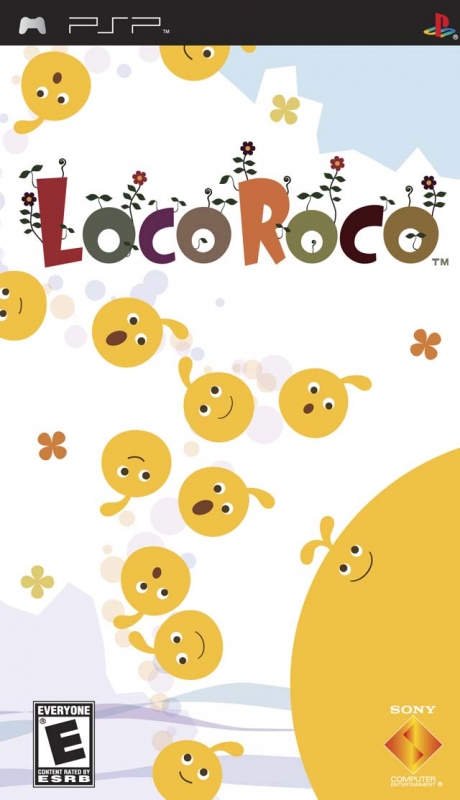
LocoRoco - Review
by Craig S , posted on 18 May 2009 / 6,406 ViewsLocoRoco is a PSP platformer which tasks you with saving some cut blobs of fun (the LocoRoco) from dreadlock-wearing baddies. It's a light-hearted game that should appeal not just to the ‘casual’ and child-friendly audiences that it’s superficially aimed at, but also to the more experienced gamers among you who want a challenging 2D platformer. On the surface, LocoRoco is a rather simple 2D side-scrolling platformer aimed at newcomers to the genre. You only ever utilise 3 buttons in-game – L, R and circle, there aren’t very many bad guys, and the chances of not making it safely to the end of the level are slim-to-none. In most platformers these would all be seen as pretty significant faults or limitations, but LocoRoco is different, these features are completely intentional, and, when combined with everything else that makes LocoRoco unique and endearing, they actually help to make an excellent handheld platformer.
The LocoRoco are a friendly race of multi-coloured creatures who like to spend all day singing, jumping and playing. That was, until the Moja came and invaded their worlds. The Moja are black dread-locked creatures (you can see one of them in the screenshot below) who like nothing more than to eat LocoRocos. By singing, rolling and jumping, the LocoRoco are able to navigate their way through each level, find and rescue their friends, and defeat the Moja, one world at a time.
Unlike most platformers, you never actually control any of the characters - instead, you tilt the environment/world (and yes, this may very well trigger motion sickness for some people, particularly if you play it for extended periods of time). Holding down the L button tilts the world to the left, while the R button tilts it to the right. As the world tilts, the LocoRoco will roll with it. In order to make your LocoRoco jump you need to press both shoulder buttons down at the same time and then release them. By using the appropriate combination of tilt and jump you are able to move through the levels, overcome puzzles and obstacles, combat the Moja, and find hidden areas full of collectibles.
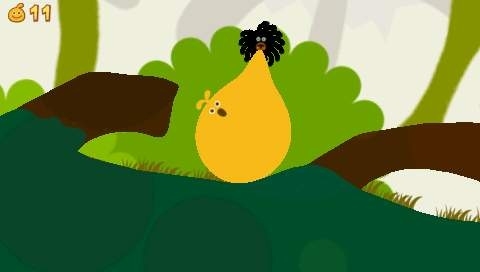
To illustrate, imagine that there is a spiked obstacle in the path ahead that you need to jump over. In order to jump far enough you will need to build up momentum, so back the LocoRoco up by pressing the L button to tilt the world left. Then release the L button and press and hold the R button to tilt the world to the right in order to build up speed, then finally, as you approach the obstacle, hold down on the L button and release at the appropriate moment to make the LocoRoco jump into the air and over the obstacle. This is just a basic example to illustrate the core mechanics - as you progress through the game the patterns of tilt and jump required to make it to the end of each level, or to find the hidden areas, become more complex, and are often combined with environmental objects to introduce new mechanics and platforming puzzles.
You’ll come across a wide assortment of these environmental elements as you travel through each of the five worlds which make up the game. They can vary from streams of air and bubbles which lift the LocoRoco up high, to sticky materials which allow them to traverse the tops of the levels, to creatures that will swallow the LocoRoco and turn them into all sorts of different shapes (squares or rectangles, and so on). Learning how to make full use of all of these environment elements is crucial to both advancing through each level and to finding all of the hidden areas in each level.
The other button you’ll use is the circle button. When you press the circle button your LocoRoco will split apart into small LocoRocos, and by holding the circle button again they'll merge back together. The number of LocoRocos you split into depends on how many red berries you’ve found and eaten throughout a given level. The more berries you eat the bigger your LocoRoco gets and the more individual LocoRocos you get when you split him/her up (up to a maximum of 20 in each level). You’ll need to split your LocoRoco up quite often in order to progress through the level as some puzzles require several LocoRoco to complete. But splitting up is dangerous. If you split up and one of your LocoRoco gets separated from the pack the Moja will find and eat him, so ideally you want to spend as little time as possible split up.
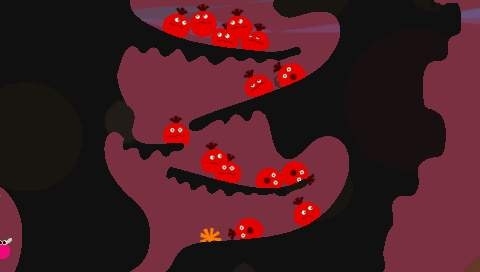
This brings me on to another key difference between LocoRoco and a typical platformer. In LocoRoco, enemies (the Moja) aren’t as prevalent as they are in most platformers. Typically you’ll encounter only a handful of the small Mojas in each level, and then a couple of ‘boss’ Mojas at the end of each world. Given the opportunity, they'll grab your LocoRoco, pluck a smaller LocoRoco from him, and will then eat it. To defeat them you need jump into them at speed, causing them to crash to the ground and vanish. You'll only die if you lose every one of your LocoRocos (from Mojas or by other means), but this is highly unlikely to happen unless you’re intentionally trying to die.
As a result, completing each level - and indeed the entire game - is a relatively straightforward affair, and you can easily breeze through the main game without ever really being challenged if you so wish. This is part of what makes LocoRoco a very child-friendly game, but it also caters towards more experienced gamers in other ways. For those of us who play games regularly, LocoRoco is able to provide a more challenging experience by way of hidden areas and collectibles. Each level will typically contain between three and five hidden areas, these are often difficult to reach areas that will require more skilful use of the core gameplay mechanics. There are usually clues as to each one’s location – for example, a wall may look slightly disjointed and often if you manage to reach it you will find a hidden area behind it, but finding all of them is a difficult task.
These hidden locations will usually contain red berries for the LocoRoco to eat, but there are also other items to collect. First of all there are Pickories. Thousands of these dot the game's levels, and they can be spent on the mini-games you unlock (more on those later). Secondly there are Mui Mui. These are little creatures friendly to the LocoRoco, and if found will reward the LocoRoco with items for their home, and they will eventually unlock the mini-games for you if you find enough of them.
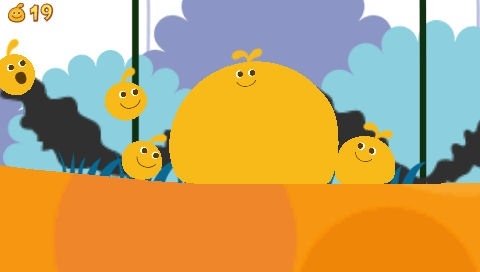
All of this is presented in a beautifully vibrant and lovable way. Each of the levels you encounter within each world is distinct, and presented in a clear and lush colour scheme. It’s the sort of graphical presentation that is perfectly suited to the portable or downloadable market. They aren’t state of the art or technically impressive in the way you expect most console games to be, but they’re in-keeping with the nature of the game. The world may consist of simple 2D geometric shapes and single-tone colours, but each object is crystal clear, brilliantly animated, and oozes style and personality.
The stars of the show are obviously the adorable LocoRoco and they have some excellent animations. As they change size over the course of the game the physics really convey the size and weight of your LocoRoco, these (eventually) huge blobs of colour contort their bodies to fit through gaps and morph into different shapes and sizes as they move about the level. They’re constantly singing and their lips move in sync with the music. When a Moja is nearby they squeal with panic (‘Moja! Moja!’), and when you split them up they seem to shake with fear. Their sense of personality really comes across, and in fact the entire game really managed to draw me into the child-like world of LocoRoco.
Each of the six different LocoRoco has its own unique design, facial expression, specific song and voice. You unlock each of the different LocoRocos as you play through the game, and once unlocked you can select whichever one you want to play as before you start each level. There are several music tracks in the game, and the LocoRoco will sing along with their own unique vocal tone as you play through the game. At certain points in each level the LocoRocos are tasked with singing their own song (which is unique to them, so there are six different LocoRoco tracks on top of the standard in-game music tracks). This adds some much needed longevity to the game, as you will want to try out each of the different LocoRoco before settling on your favourite(s) (although I think that the first LocoRoco is easily the best).
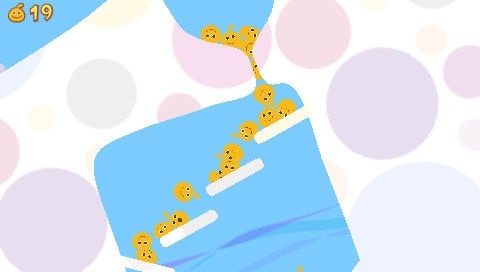
As I’ve said a couple times in this review, completing the game is a relatively straightforward affair if you don’t go out of your way to find all of the hidden areas. It took me seven hours to complete the main game, and during that playthrough I typically only managed to find a couple of the hidden areas and around 13-17 of a possible 20 LocoRoco in each level. So if you’re just seeking to play through the main story expect it to take around five to eight hours, depending on your ability and how many of the hidden areas you want to find. If you’re the sort of person who likes collecting things and perfecting your level times (the game keeps track of all of your statistics for each level), or you’re interested in making full use of the mini-games and LocoRoco house, then the sky is the limit in terms of play time.
There are three ‘mini-games’ in total. The first is the Mui Mui Crane, which is similar to the one found in real-world arcades, and just like with those, grabbing stuff (in this case items for your LocoRoco house) with the claw is much harder than it looks. The second one is the Chuppa Chuppa mini-game, which is much more interesting. Here you have to launch a LocoRoco around a maze while attempting to avoid spiked obstacles, and it’s a pleasantly difficult and strategic diversion from the main game. The third unlockable is a variation on a level editor, which allows you to create your own levels and then send them to friends, and whilst the concept is sound it’s not as involving as it could have been. Finally, there’s the LocoRoco house (it’s not classed as a mini-game, hence why I listed it separately), which is essentially an area where you can place all of the items you’ve collected throughout the game and then watch as your LocoRoco interact with them. Also it’s briefly worth mentioning that you can take an in-game photo at any point in the game, which is then stored in a photo album for use on your computer or as a custom theme.
These mini-games and bonus content really only provide a very brief diversion from the main game. It’s a game that’s undoubtedly meant to be replayed, but in reality I’m not sure how many people actually will given the often repetitive nature of the five worlds. Whilst each level within a world is very distinct there is often a repetition of concepts and challenges from world to world, which is a shame, and it really did reduce my desire to replay the entire game. It’s also disappointing that the standard game never really becomes challenging unless you go out of your way to find a challenge. Whilst this certainly allows the game to play to two audiences, I still feel the difficulty could have increased more over the course of the game without alienating a younger audience.

LocoRoco maintains a fine balance in appealing to two different audiences. With its vibrant and simple art style, infused with a cheery love for simple songs and adorable blobs of colour, LocoRoco is a game that on the face of it is clearly marketed towards a younger audience, and true to form this is born out in the simple controls and ease of completion. And yet, behind this initial layer of child-friendly gameplay is a much deeper game, filled with hidden areas and, at times, frustratingly challenging gameplay that should really appeal to the more experienced gamer. There are drawbacks to LocoRoco - it is a short game, even for a handheld platformer, and given this it’s surprising to also find a fair amount of repetition and asset re-use from world to world as well. Just be aware of this going into the game and you’ll quite possibly find that, despite its length, LocoRoco is one of the best games on the PSP.
VGChartz Verdict
8
Great
























